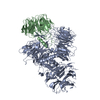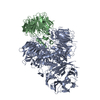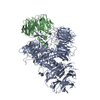[English] 日本語
 Yorodumi
Yorodumi- PDB-6bm0: Cryo-EM structure of human CPSF-160-WDR33 complex at 3.8 A resolution -
+ Open data
Open data
- Basic information
Basic information
| Entry | Database: PDB / ID: 6bm0 | ||||||
|---|---|---|---|---|---|---|---|
| Title | Cryo-EM structure of human CPSF-160-WDR33 complex at 3.8 A resolution | ||||||
 Components Components |
| ||||||
 Keywords Keywords | PROTEIN BINDING / Polyadenylation / scaffolding protein / WD40 | ||||||
| Function / homology |  Function and homology information Function and homology informationco-transcriptional RNA 3'-end processing, cleavage and polyadenylation pathway / Processing of Intronless Pre-mRNAs / mRNA cleavage and polyadenylation specificity factor complex / collagen trimer / mRNA 3'-UTR AU-rich region binding / mRNA 3'-end processing / Transport of Mature mRNA Derived from an Intronless Transcript / mRNA 3'-end processing / tRNA processing in the nucleus / postreplication repair ...co-transcriptional RNA 3'-end processing, cleavage and polyadenylation pathway / Processing of Intronless Pre-mRNAs / mRNA cleavage and polyadenylation specificity factor complex / collagen trimer / mRNA 3'-UTR AU-rich region binding / mRNA 3'-end processing / Transport of Mature mRNA Derived from an Intronless Transcript / mRNA 3'-end processing / tRNA processing in the nucleus / postreplication repair / RNA Polymerase II Transcription Termination / Processing of Capped Intron-Containing Pre-mRNA / fibrillar center / mRNA processing / spermatogenesis / enzyme binding / RNA binding / nucleoplasm / nucleus Similarity search - Function | ||||||
| Biological species |  Homo sapiens (human) Homo sapiens (human) | ||||||
| Method | ELECTRON MICROSCOPY / single particle reconstruction / cryo EM / Resolution: 3.8 Å | ||||||
 Authors Authors | Sun, Y. / Zhang, Y. / Hamilton, K. / Walz, T. / Tong, L. | ||||||
| Funding support |  United States, 1items United States, 1items
| ||||||
 Citation Citation |  Journal: Proc Natl Acad Sci U S A / Year: 2018 Journal: Proc Natl Acad Sci U S A / Year: 2018Title: Molecular basis for the recognition of the human AAUAAA polyadenylation signal. Authors: Yadong Sun / Yixiao Zhang / Keith Hamilton / James L Manley / Yongsheng Shi / Thomas Walz / Liang Tong /  Abstract: Nearly all eukaryotic messenger RNA precursors must undergo cleavage and polyadenylation at their 3'-end for maturation. A crucial step in this process is the recognition of the AAUAAA ...Nearly all eukaryotic messenger RNA precursors must undergo cleavage and polyadenylation at their 3'-end for maturation. A crucial step in this process is the recognition of the AAUAAA polyadenylation signal (PAS), and the molecular mechanism of this recognition has been a long-standing problem. Here, we report the cryo-electron microscopy structure of a quaternary complex of human CPSF-160, WDR33, CPSF-30, and an AAUAAA RNA at 3.4-Å resolution. Strikingly, the AAUAAA PAS assumes an unusual conformation that allows this short motif to be bound directly by both CPSF-30 and WDR33. The A1 and A2 bases are recognized specifically by zinc finger 2 (ZF2) of CPSF-30 and the A4 and A5 bases by ZF3. Interestingly, the U3 and A6 bases form an intramolecular Hoogsteen base pair and directly contact WDR33. CPSF-160 functions as an essential scaffold and preorganizes CPSF-30 and WDR33 for high-affinity binding to AAUAAA. Our findings provide an elegant molecular explanation for how PAS sequences are recognized for mRNA 3'-end formation. | ||||||
| History |
|
- Structure visualization
Structure visualization
| Movie |
 Movie viewer Movie viewer |
|---|---|
| Structure viewer | Molecule:  Molmil Molmil Jmol/JSmol Jmol/JSmol |
- Downloads & links
Downloads & links
- Download
Download
| PDBx/mmCIF format |  6bm0.cif.gz 6bm0.cif.gz | 292.8 KB | Display |  PDBx/mmCIF format PDBx/mmCIF format |
|---|---|---|---|---|
| PDB format |  pdb6bm0.ent.gz pdb6bm0.ent.gz | 223.8 KB | Display |  PDB format PDB format |
| PDBx/mmJSON format |  6bm0.json.gz 6bm0.json.gz | Tree view |  PDBx/mmJSON format PDBx/mmJSON format | |
| Others |  Other downloads Other downloads |
-Validation report
| Summary document |  6bm0_validation.pdf.gz 6bm0_validation.pdf.gz | 890.6 KB | Display |  wwPDB validaton report wwPDB validaton report |
|---|---|---|---|---|
| Full document |  6bm0_full_validation.pdf.gz 6bm0_full_validation.pdf.gz | 928.5 KB | Display | |
| Data in XML |  6bm0_validation.xml.gz 6bm0_validation.xml.gz | 48.5 KB | Display | |
| Data in CIF |  6bm0_validation.cif.gz 6bm0_validation.cif.gz | 71.6 KB | Display | |
| Arichive directory |  https://data.pdbj.org/pub/pdb/validation_reports/bm/6bm0 https://data.pdbj.org/pub/pdb/validation_reports/bm/6bm0 ftp://data.pdbj.org/pub/pdb/validation_reports/bm/6bm0 ftp://data.pdbj.org/pub/pdb/validation_reports/bm/6bm0 | HTTPS FTP |
-Related structure data
| Related structure data |  7114MC  7112C  7113C  6blyC  6dnhC M: map data used to model this data C: citing same article ( |
|---|---|
| Similar structure data |
- Links
Links
- Assembly
Assembly
| Deposited unit | 
|
|---|---|
| 1 |
|
- Components
Components
| #1: Protein | Mass: 161074.234 Da / Num. of mol.: 1 Source method: isolated from a genetically manipulated source Source: (gene. exp.)  Homo sapiens (human) / Gene: CPSF1, CPSF160 / Production host: Homo sapiens (human) / Gene: CPSF1, CPSF160 / Production host:  Trichoplusia ni (cabbage looper) / References: UniProt: Q10570 Trichoplusia ni (cabbage looper) / References: UniProt: Q10570 |
|---|---|
| #2: Protein | Mass: 67546.812 Da / Num. of mol.: 1 Source method: isolated from a genetically manipulated source Source: (gene. exp.)  Homo sapiens (human) / Gene: WDR33, WDC146 / Production host: Homo sapiens (human) / Gene: WDR33, WDC146 / Production host:  Trichoplusia ni (cabbage looper) / References: UniProt: Q9C0J8 Trichoplusia ni (cabbage looper) / References: UniProt: Q9C0J8 |
-Experimental details
-Experiment
| Experiment | Method: ELECTRON MICROSCOPY |
|---|---|
| EM experiment | Aggregation state: PARTICLE / 3D reconstruction method: single particle reconstruction |
- Sample preparation
Sample preparation
| Component | Name: Binary complex of human CPSF-160-WDR33 / Type: COMPLEX Details: WDR33 is bound between the top faces of b- propeller A and C in CPSF-160 Entity ID: all / Source: RECOMBINANT |
|---|---|
| Molecular weight | Value: 0.225 MDa / Experimental value: YES |
| Source (natural) | Organism:  Homo sapiens (human) Homo sapiens (human) |
| Source (recombinant) | Organism:  Trichoplusia ni (cabbage looper) Trichoplusia ni (cabbage looper) |
| Buffer solution | pH: 7.9 / Details: 25 mM Tris-HCl, pH 7.9, 300 mM NaCl, 5 mM DTT |
| Buffer component | Conc.: 0.3 mM / Name: sodium chloride / Formula: NaCl |
| Specimen | Conc.: 1.8 mg/ml / Embedding applied: NO / Shadowing applied: NO / Staining applied: NO / Vitrification applied: YES Details: CHAPSO (8 mM final concentration) was added to prevent the particles from adopting preferred orientations in the ice layer |
| Specimen support | Grid material: GOLD / Grid mesh size: 300 divisions/in. / Grid type: Quantifoil R1.2/1.3 |
| Vitrification | Instrument: FEI VITROBOT MARK IV / Cryogen name: ETHANE / Humidity: 100 % / Chamber temperature: 277 K |
- Electron microscopy imaging
Electron microscopy imaging
| Experimental equipment |  Model: Titan Krios / Image courtesy: FEI Company |
|---|---|
| Microscopy | Model: FEI TITAN KRIOS |
| Electron gun | Electron source:  FIELD EMISSION GUN / Accelerating voltage: 300 kV / Illumination mode: FLOOD BEAM FIELD EMISSION GUN / Accelerating voltage: 300 kV / Illumination mode: FLOOD BEAM |
| Electron lens | Mode: BRIGHT FIELD / Nominal magnification: 225000 X / Calibrated magnification: 38462 X / Nominal defocus max: 2700 nm / Nominal defocus min: 1300 nm / Calibrated defocus min: 800 nm / Calibrated defocus max: 3000 nm / Cs: 2.7 mm / C2 aperture diameter: 100 µm |
| Specimen holder | Cryogen: NITROGEN / Specimen holder model: FEI TITAN KRIOS AUTOGRID HOLDER |
| Image recording | Average exposure time: 10 sec. / Electron dose: 47 e/Å2 / Detector mode: SUPER-RESOLUTION / Film or detector model: GATAN K2 SUMMIT (4k x 4k) / Num. of grids imaged: 1 / Num. of real images: 1625 |
| Image scans | Movie frames/image: 40 / Used frames/image: 1-40 |
- Processing
Processing
| EM software |
| |||||||||||||||
|---|---|---|---|---|---|---|---|---|---|---|---|---|---|---|---|---|
| CTF correction | Type: PHASE FLIPPING AND AMPLITUDE CORRECTION | |||||||||||||||
| Particle selection | Num. of particles selected: 372707 | |||||||||||||||
| Symmetry | Point symmetry: C1 (asymmetric) | |||||||||||||||
| 3D reconstruction | Resolution: 3.8 Å / Resolution method: FSC 0.143 CUT-OFF / Num. of particles: 205373 / Symmetry type: POINT |
 Movie
Movie Controller
Controller








 PDBj
PDBj


